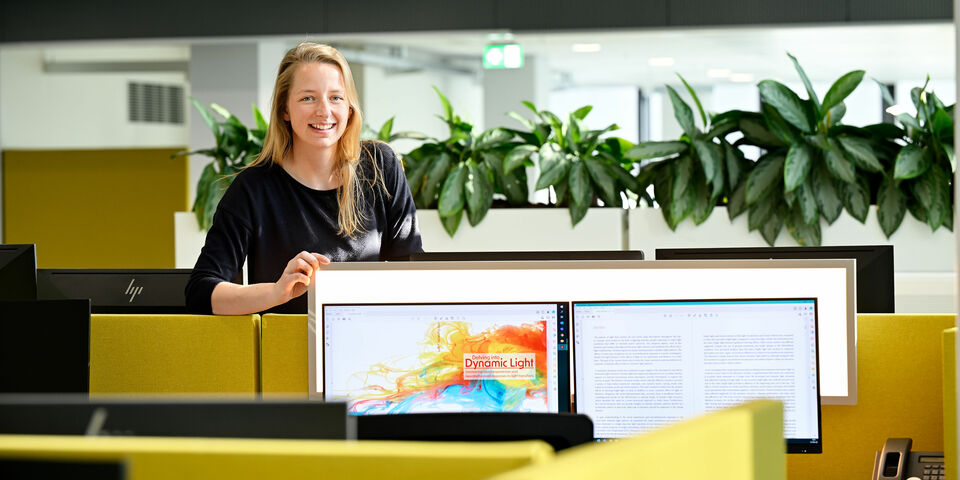Home Stretch | Shine a light at work
When we put our clocks forward last weekend for daylight saving time, we lost one hour of sleep and the mornings became darker again. This change of light disrupts our biological clock for a few days. But how does that work with changes in artificial light? TU/e researcher Maaike Kompier studied the effects of dynamic light on our state of mind and behavior. First and foremost, however, she recommends a workplace close to a window and lunchtime walks. She will defend her thesis at the department of IE&IS on Tuesday, the 5th of April.
Daylight has a significant effect on our biological clock – the internal mechanism that regulates a number of processes that occur in our body according to a certain rhythm. Think of body temperature, heart rate, organ functions, hormone levels and our slape-wake cycle. In short: it determines when we want to eat, sleep and how active we are. The color spectrum and intensity of daylight changes during the day and influences these processes. In particular, the large dynamic range with much light starting early in the morning until late in the afternoon, and little to no light early in the evening and at night, determines when the human body starts to secrete melatonin and become sleepy.
Electric light is often used to simulate the pattern of a natural light environment, PhD student Maaike Kompier says. She worked within the DYNKA project during the past four years and conducted research into the effects of dynamic, electric light on our state of mind. “Much more is possible nowadays, technologically speaking. You can adjust the color and intensity of light over the course of the day, so that it starts to resemble daylight. But is that equally effective? Do we really become more alert when the lights at the office turn slightly blue, and do we sleep better when the intensity of indoor lighting varies during the day? There are quite a few dynamic lighting systems available on the market already, but much still remains unclear when it comes to the usefulness and efficacy of these devices.”
Various light scenarios
Time to shine a light on the matter. Before Kompier started to expose test subjects to darkness and light, she looked into previously conducted studies on lighting. The results differed considerably. “First you find many different settings, ranging from hospitals to school buildings, and there are various light scenarios. That makes it difficult to compare results. In addition, the effects of light are often subdivided into visual effects – how much we see and how well we can read – and non-visual effects: a wide group of effects on sleep, alertness and performace, for example. The results are conflicting, but the most important conclusion perhaps is that this subdivision isn’t optimal. A more detailed study of the effects of light on behavior requires a more detailed subdivision. Only then will you gain more insight into the exact workings of dynamic light patterns, and into what kind of dynamics and timing might be most effective.”
In short: a wide variety of parameters, which is why Kompier decided to start with a simple study. Test subjects were seated in a climate chamber and asked to carry out a computer task. Meanwhile, Kompier changed the intensity and color of the light in the chamber once. The responses to that simple light pattern varied more than she had imagined, Kompier says. “We saw how certain effects, such as those on comfort and mood, disappeared rather rapidly after the change in light setting. Other effects however, on alertness and vitality for example, disappeared much more gradually.”
Breath of light
The light scenarios became increasingly complex, until the moment of the large experiment in Atlas. Kompier developed two dynamic light schemes and tested these on a group of TU/e employees. For six weeks, their sleeping patterns, alertness, task performances and visual experiences were monitored daily. As it turned out, Kompier’s study didn’t show any indications that dynamic light influences alertness and task performances.
Does this mean that those high-tech dynamic lighting systems you find in more and more offices are useless? No, Kompier stresses immediately. “Our study shows that you need to be very careful with more nuanced dynamics; alertness and productivity-enhancing effects remain highly uncertain. At the same time, you might lose a lot of lighting comfort with major and rapid changes in lighting. We definitely need more research, preferably with more subgroups. Dynamic light definitely has a positive effect on other aspects, including sleep.”
“Our research also shows that different types of light and sufficient exposure to light can improve sleep quality. Artificial light that changes could potentially contribute to that during the winter months. But equally important: go out on time for a ‘breath of light’, for example by taking a walk at lunchtime. And a desk next to a window is something I also recommend.”
Extra light can also help people get over their ‘jetlag’ from moving the clock forward or backward, Kompier says. A tip for next year: if you want to show up at work feeling fresh after daylight saving time starts, the best thing to do is to make some changes to your behavior in advance. “Go to bed earlier the week before, and get out of bed on time. And expose yourself to enough light in the morning: turn on a bright lamp immediately after you wake up, or go outside.”


Discussion